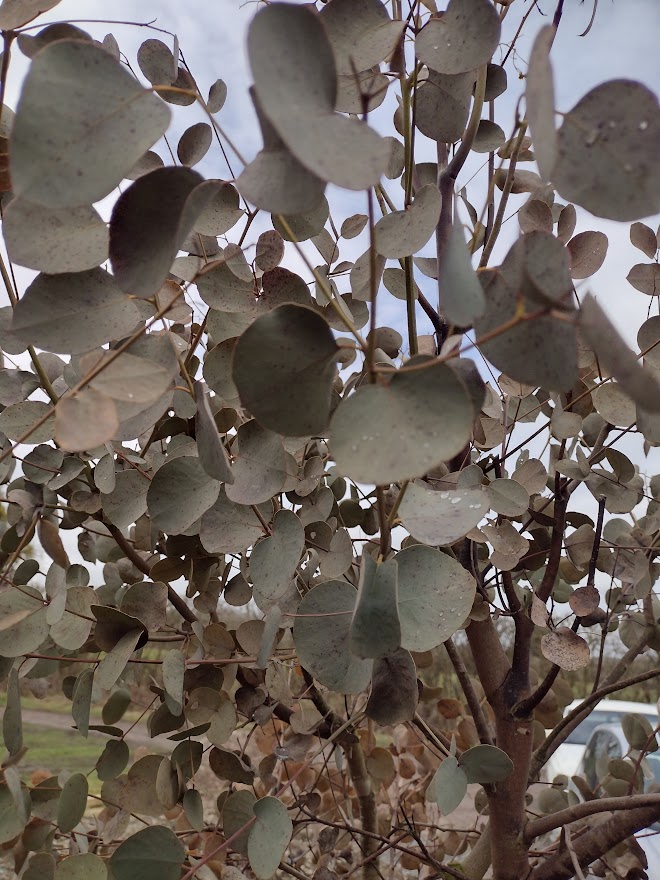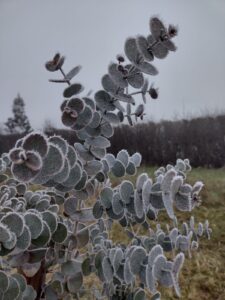
So your Eucalyptus has got brown and crispy foliage and you want to know if it’s going to leaf out again or for that matter – is it still alive after this winter?
It’s early March 2023 as I write this and the leafy crispiness of Eucalyptus is as a result of the wind chill factor we received not only during December 2022, but also through a large part of January 2023. Some parts of the UK were very badly hit. The problem was compounded by the fact that after the first freeze, we had some quite mild temperatures during the latter part of December only to be followed by the second freeze. This is not significant for an oak tree in winter dormancy, but it is deeply significant for a Eucalyptus. Eucalyptus biology is a bit unusual. They never go fully dormant, like an oak, but drift into a sort of suspended animation. During the growing season, Eucalyptus sap is watery and they grow very quickly. With the arrival of Autumn, Eucs undergo a frost-proofing process. When the night time temperatures consistently hit +5°C in the Autumn, their sap thickens – becomes more sugary and acquires proteins – to prevent the formation of ice crystals,. Growth slows right down and they lay down fibre (woody material). It is expected that temperatures throughout the winter months should remain cold. Whilst it remains cold, Eucalyptus maintain their frost-proof sugary sap. If the winter temperatures consistently rise above +5°C, within a matter of days they drop their winter defences , their sugary sap becomes watery and they start right into growth. This leaves them very vulnerable to frost damage. It can take two weeks for them to get back into their frost protected status again.
Unfortunately for Eucalyptus, the weather of winter of 2022/2023 was unusual. There was a frozen warm sandwich! Our Grafton Nursery weather station recorded two weeks of freezing conditions in early/mid December followed by two weeks of uncharacteristically warm weather above 8°C late December, and then another two weeks of freezing windy conditions. This has been disastrous for many Eucalyptus.
The wind ferociously stripped moisture out of the leaves and it is as if the Eucs experienced a forest fire but at sub-zero temperatures. We recorded an unnecessary -13°C on our local weather station here at Hardy Eucalyptus HQ and I know many people around the UK had the same, if not worse. Some places in Kent recorded -17°C, whereas some locations in North-east Scotland briefly experienced only -7°C.
The question is – what to do now? The simple answer is a frustrating ‘wait and see’! Eucalyptus are incredibly resilient and have the ability to bounce back. The leaves may have scorched, along with their immediate branchlets, but the structural branches may be fine, the trunk lower down could still be sound and with several species, if all else fails, the lignotuber right at the base of the tree may be ready to leap into action sometime in May.

I believe that many Eucalyptus are deciduous under stress. It requires quite a degree of effort for a plant to maintain good quality foliage in the face of adversity. They manage to be evergreen for most of the time; when conditions are optimum, water in good supply, temperatures not too cold. However, give them a serious drought or a night time windchill factor of -13°C for weeks on end and I think it’s fair to assume that they are not going to be able to hang on to their foliage. Their leaves will go brown and crispy, and fall. Your Eucalyptus will wait until better conditions arrive, before it leafs out again.
There are several factors at play here.
Hardiness is not binary. It should be thought of as a sliding scale. Many conditions conspire to ruin a plant’s state of hardiness. Consider a rose bush. Dormant and hardy through the worst of UK winter weather, it leafs out with fresh delicate foliage in the warm Spring sunshine and begins to form flower buds. 12 weeks later it comes into flower, but if there is a cold snap in May with radiation frost, those leaves will go black overnight. Pine trees can be frozen solid throughout the winter in Scotland. They come into growth in a warm spring and yet can be absolutely killed by a radiation frost late Spring, because the warmth contributed to their loss of winter hardiness, leaving them vulnerable. And so it is with Eucalyptus, when there is a series of warm days in the dead of winter.
The species and seed-provenance of your Eucalyptus will determine how successfully it will bounce back under these conditions. I very optimistically planted E. ligustrina outside my office last Autumn, just to see what it would do. It generally will tolerate -8C and currently looks distinctly miffed; I doubt it will survive. Whereas, the E. parvula in our field are still ‘smiling’ in spite of everything!
The age of your tree will dictate its resilience to such a winter as this. Young trees only have periderm as an overcoat – think thin orange peel. Whereas older trees of 6 years or more will have ‘proper bark’, a full metal jacket protecting the sap-carrying tissues that lie beneath, from the sub-zero temperatures.
Not only does size and age matter, but after the winter we have just witnessed, we learned that how long a tree has been planted in the ground is a significant factor over how well it will cope with these terrible conditions. We have small, young stock in our field, of only 2 years planting, doing really well across a range of species; whereas a Snow gum in a 30 litre airpot of several years growth, which Ben enthusiastically planted last October, has lost all its foliage. The branchlets and trunk look green and healthy and it will no doubt leaf out this spring, but right now – it is bald!
How your tree was planted will matter also. Was the hole dug deeply down to 450mm, was there a layer of compacted clay to be removed? Was planting mix or sharp sand, combined with good quality topsoil, installed under the root-ball and was Rootgrow used? These seemingly insignificant details all add up to encouraging a deeply rooted tree. At 450mm depth, in lowland Britain, the soil is typically a constant +6°C, which means that water will be available for uptake. Deeply rooted Eucs can access this moisture and replenish some of the water lost through its foliage. Shallow rooted Eucs undergo desiccation, because their root system is trapped in frozen ground. More young Eucalyptus die from drought in a cold winter than from the cold itself.
And finally, where your tree is growing will strongly influence survival rates. A sheltered urban garden will always be environmentally more protected than a windy, exposed rural pasture; the wilds of Scotland always more bracing than the balmy southwest of England!
Your Eucalyptus is like an Olympic athlete. Maximum performance is achieved through a series of marginal gains. Every little point achieved above contributes towards a happier and more resilient tree.
So where do you go from here?
When to prune: any time from March 18th (National Eucalyptus Day) up to the end of March, and certainly not past the middle of April. The further north you are, the later you will want to prune. For now, prune out what you know to be dead wood. Then wait until your tree re-sprouts. At this point, you will definitely know the difference between live and dead tissue and can then prune out remaining dead wood.
Once you have found the live tissue, stand back and assess your tree. If you prune the dead top growth down to this point, will it grow back as a bush or will you be able to train it back up into a tree? There is no one answer to this question. It requires some thought, taking into consideration how the tree will react during the growing season. If the pruning is a big job, then we recommend you acquire the services of a trained professional horticulturist or tree surgeon.
Eucalyptus pruning wounds can become infected with Silver Leaf Fungus. Pruning requires clean (sterilising in vodka/alcohol), sharp pruning equipment. Large pruning wounds require treatment with a wound paint such as the Prune and Seal made by Growing Success.
New growth can emerge from any part of the tree trunk or branches. The photographs of Eucalyptus trees leafing out after the terrible forest fires over the past two years serve to illustrate how impressive these trees are at bouncing back after crises. The magic zone for Eucs is from ground zero up to around 1.2m. An amazing evolutionary survival trait developed after millenia of forest fires has resulted in thousands of epicormic buds lying dormant in this region, snoozing under the periderm or bark, just waiting for the call of duty.
If you don’t find any live tissue in the upper parts of the tree, don’t despair yet. It may well be that the roots are still alive and will activate their secret defence mechanism – the lignotuber* at the base of the trunk. It is best to prune the tree down to about 100mm (4 inches) above ground level. To give your tree the best chance possible, clear away any weeds or grass around the base, mulch the area with bark chips and give the tree a good deluge of water. For a lignotuber to ‘pop’, it requires warmth and water and the lignotuber may not ‘pop’ out new shoots until the end of May or even July.
Once new growth emerges, be sure to look after your tree. Continue watering, mist the new foliage with cold-pressed seaweed solution such as Alg-a-mic to give it a whole host of plant growth hormones. Feed your tree with a high potash fertiliser such as our Eucalyptus Smart Fertiliser. Train the new growth to fashion the shrub or tree shape you are looking for. Select a strong leading shoot if you are after a standard. Pinch out dominant shoots if you want a bushy shrub.
If you have a very large tree, if might not be possible to get that close to the canopy and it may be that you have to just wait and see from where it leafs out. This can take until July. If there is a great deal of dead wood in the crown, you will require the services of a tree surgeon, to clean it out. Ensure they carry out any pruning for you before the end of July. Eucalyptus wounds really only heal whilst sap is actively rising.
So your tree has had a bad winter. Either the leaves are looking shot or there is no sign of life, but don’t give up on it too soon. Try to be patient. Wait until the warm weather of early summer arrives, before you decide to declare it missing in action!
*Not all Eucalyptus have a lignotuber, so you may need to check the individual tree species data sheets in the shop on our website for that information.
Tel: 01905 888 098
Monday-Friday, 9.00am-4.00pm
Grafton Nursery,
Worcestershire
(Visits by appointment)


We’re here to help you choose your Eucalyptus
We’ll also email you with expert seasonal advice for
your Eucalyptus & exclusive offers. No spam – just Eucalyptus.
You can opt out at any time. Click here to see our privacy policy in full.